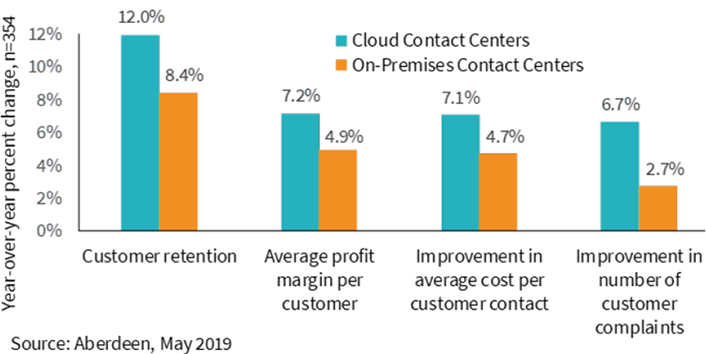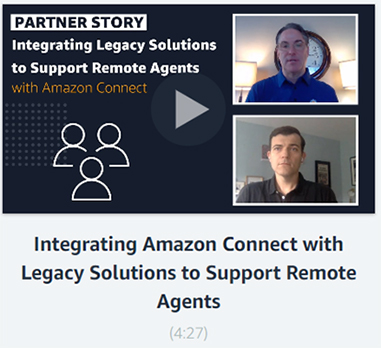This article discusses three key factors—cost, flexibility, and customer experience—that influence the introduction of cloud technologies into higher ed contact centers.
As organizations face rising customer expectations for personalization and interaction, the limits of on-premises contact centers are evident. Higher education institutions have been adopting cloud-based contact centers to address this concern. According to a recent study by Aberdeen Research, the adoption of cloud technology to modernize contact centers increased 94 percent between 2013 and 2019.1
On a typical day, colleges and universities field thousands of questions from students, faculty, and staff, while changing stay-at-home mandates require institutions to provide consistent, up-to-date, real-time communication. With students, staff, and faculty no longer able to visit in-person help desks due to the coronavirus pandemic, institutions are increasingly relying on their contact centers to bridge the resulting services gap.
For institutions with legacy contact-center solutions, this shift has created challenges in maintenance, scale, and innovation. Traditional on-premises contact centers make it challenging to create a personalized experience while iterating at the pace of rapidly changing conditions.
To better understand the factors influencing the adoption of cloud contact centers in higher education institutions, we spoke with three technical experts from the Amazon Web Services (AWS) Partner Network (APN) who specialize in the deployment of Amazon Connect, a cloud contact center: Bryan Carmichael of VoiceFoundry; Jim Walker of CloudHesive; and Amas Tenumah of RockITData [https://rockitdata.com/home-new/].
1. Lower total cost of ownership
Aberdeen Research cites the financial structure of cloud technologies as the foremost reason for preferring a cloud contact center by those who migrated. Simply put, cloud-based contact centers cost less than legacy contact-center systems.2
Jim Walker, chief executive officer (CEO) of CloudHesive, helps institutions modernize their customer experience with Amazon Connect. Amazon Connect provides a cloud-based contact center with no minimum monthly fees, long-term commitments, or upfront license charges. In addition, the pricing of Amazon Connect is not based on peak capacity, agent seats, or maintenance. Based on his experiences, the total cost of ownership was the main advantage of adopting Amazon Connect. Walker said, "Besides that Amazon Connect is easy to use from agent and operational perspectives, the biggest benefit is that there are no contracts, and you pay only for the time you spend interacting with customers. And you don't have to deal with implementing telecommunications services. Amazon Connect does all that for you."
2. Flexibility to add capacity and capability
Aberdeen Research found that scalability and elasticity are the other top reasons cited for migrating to a cloud-based contact center, after cost.
Legacy contact centers limit opportunities for automation and self-service. Employees and students should be able to execute simple IT requests, such as password resets, without agent intervention. Long hold times present another challenge. One education institution estimated the hold time for an average caller was six minutes but could extend to fifty-four minutes during peak call volumes. Legacy contact-center infrastructure is cumbersome to maintain, upgrade, and support.
"When COVID-19 struck campuses in spring 2020, the University of Arizona relied on Amazon Connect to move within days to a remote customer-agent environment," said Bryan Carmichael, director of Strategic Accounts at VoiceFoundry. With VoiceFoundry's guidance, the University of Arizona used Amazon Connect for simple integration with third-party solutions to run email and voice campaigns aimed at impacted constituents. The contact center provides agents with multilanguage support, a single pane of glass to assess a caller's status, and personalized responses to the caller.
According to Carmichael, "Higher education staff need the ability to work as effectively and efficiently as they would when physically in an office. It is imperative that they be able to extend the same experience when students are at home or away."
3. Improved customer experience
Aberdeen Research attributes the success of cloud-based contact centers to improved customer satisfaction. Organizations that adopt cloud for their contact centers report two-and-a-half times better performance on improvement with customer complaints than those that on-premises contact center reported.3
Cloud Contact Centers Achieve Superior Customer Experience

Amas Tenumah, Rockitdata contact-center consultant, recognizes how quickly organizations can set up an omnichannel contact center and immediately begin engaging with their students, staff, and administration. "Schools are asking, 'How can we scale our footprint and take more calls, emails, etc.?' The beauty of Amazon Connect is we can now deliver this scale not in months or years but in days or hours. But equally important is elasticity. You want to be able to scale, but you can't afford to have one-hundred-times capacity at all times. With Amazon Connect, we bring to bear the ability for institutions to shrink capacity when it's no longer needed, so as your volume goes up and down, you can deliver the best experience possible."
Amazon Connect has a single user interface across both voice and chat for contact routing, queuing, analytics, and management. This means every customer interaction is immediately available across voice and chat channels without any duplication of effort.
Managing Risks: A phased migration to cloud capabilities
Table 1: Top Reasons Why On-Premises Contact Centers Haven't Moved to the Cloud
| Top Reasons Why On-Premises Contact Centers Haven't Shifted to Cloud Technology | On-Premises Contact Centers |
|---|---|
| We want to maintain full controll of our data internally | 52% |
| Lack of budget needed to deploy new technologies | 41% |
| Struggle aligning all stakeholders to change our technology infrastructure | 40% |
| Need to justify investment in existing (on-premises) tools | 34% |
| Concern that the transition to cloud will be complex and there isn't enough internal expertise to successfully manage it | 32% |
| Risk of disruptions in business continuity | 29% |
The question in the above table was asked as a multi-choice question, meaning that firms may cite more than one factor as reasons why they haven't migrated from an on-premises to a cloud model.
The study from Aberdeen Research highlights feedback from respondents whose organizations have not migrated from their legacy contact center to cloud capabilities.4 The risks of disruption, complexity, and control of data were cited as major reasons.
Migration need not be complex, according to Aberdeen. In fact, some of the services—including Amazon Connect—can be set up in concert with the legacy infrastructure within minutes. For concerns about the complexity of migration, Aberdeen recommends a phased approach to migration, focusing first on adopting cloud contact-center capabilities that are likely to have the greatest impact on productivity.
To learn more, download Cloud Contact Center Buyer's Guide: How to Achieve Maximum Results through Cloud Technology by Aberdeen Research, or visit here for publicly available resources on Amazon Connect.
Notes
- Omer Minkara, Cloud Contact Center Buyer's Guide: How to Achieve Maximum Results through Cloud Technology, research report, (Waltham, MA: Aberdeen Research, 2019). ↩
- Ibid. ↩
- Ibid. ↩
- Ibid. ↩
Nader Nanjiani is Senior Product Marketing Manager at Amazon Web Services.
Liz Rowan is Partner Marketing Manager at Amazon Web Services.
© 2020 Amazon Web Services.




